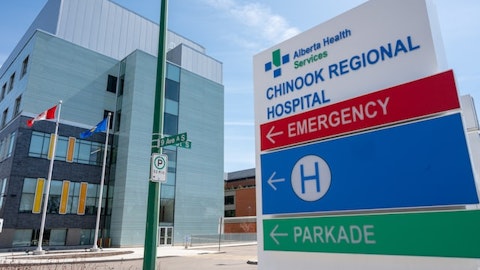Dave Dupuy: Yes. What you can do is you can look obviously at our supplemental and look at the Fort Myers property and kind of come up with what is a monthly rent number. So, we have received two months of rent in the third quarter, which we obviously did not receive in the fourth quarter, you can kind of call that $130,000, $140,000. There was also some expense reimbursement that isn’t as visible, but that obviously impacted the loss of that reimbursement in the fourth quarter. And then obviously, in the fourth quarter, we also now, we are paying for some of those expenses ourselves as opposed to having at least a couple of months reimbursed in the third quarter. So, all of those added up to – as you look at the quarter-over-quarter sequential impact, you can kind of see where that 10-year or so came from.
Wes Golladay: Okay. Thanks a lot for that.
Dave Dupuy: Thanks Wes.
Operator: The next question comes from Barry Oxford with Colliers. Please go ahead.
Barry Oxford: Great. Thanks guys. Real quick one, you guys are talking about long-term debt. Have you kind of talked to any of the banks where 5-year or 10-year money might be priced for you guys at this particular juncture?
Dave Dupuy: Barry, where we are right now with the availability we have under our revolver and not having any near-term maturities, our next maturity is not until March of 2026. We continue to monitor those markets and where pricing is. But since we don’t have an immediate need, it’s not a focus of ours. Again, I think as we look at the interest rate outlook, we feel like some of the headwinds that everyone has experienced over the last 12 months, 18 months have at least subsided and we seem to be in a more stable interest rate environment. And look, we hope later this year and into next year, it’s a more favorable interest rate environment. And I think at that point, that is when we would maybe be more interested in taking a harder look at some of the different financing environments.
Barry Oxford: Well, I will take a closer look at that point. That makes sense for the other management teams to kind of echo the same thing. In your acquisition pipeline, what type of assets are in there, is it the MOBs or acute care, long-term care facilities? Is there a particular weight to one of those asset classes, or is it, look, it’s kind of across the board of what we normally buy?
Dave Dupuy: It’s really kind of across – Barry, by the way good to hear from you. Good to talk to you….
Barry Oxford: Yes. Great.
Dave Dupuy: You have joined the team here. But I would characterize our pipeline is really being similar to what it’s been roughly half or a little bit more around the physician clinic, MOB side of things. And maybe that’s, you can call it, 60% plus or minus. And then the other side of the pipeline is more of the client single-tenant type of opportunity set, which includes everything from behavioral and patient rehab to a variety of – and actually dialysis too. So, that’s kind of the mix today that we are seeing. And so we like that mix. We think it’s a good mix of property type, and we expect that, that sort of mix in general will continue into 2024.
Barry Oxford: Great. Appreciate the color guys. Thanks so much.
Dave Dupuy: Thank you.
Operator: The next question comes from Ethan Brown with Cox Capital Markets. Please go ahead.
Ethan Brown: Hi guys. Thanks for taking my question. I wanted to ask just more of a high-level question about AFFO. I mean when I – when we look at that on a per share basis, we are coming up on kind of our third year of that metric being relatively flat at a time when the asset base has continued to grow at a pretty moderate rate. So, at what point do you regain some of that operational leverage to drive AFFO per share? And just how do you internally think about driving that metric? Thank you.
Dave Dupuy: Well, thank you for the question. What I would tell you is if you take a step back and look at the environment that we have been operating in over the last couple of years, it’s been in an increasing interest rate environment. And so unfortunately, during that same period of time, even though we have been acquiring assets, our spread has compressed rather meaningfully. We are very focused on AFFO. That’s how we are all rewarded internally, and we are laser focused on growing that number. But unfortunately, interest rates have gone up pretty significantly during that 18 months to 24 months period of time. And so a lot of that acquisition growth that would have flown – that would have moved through our AFFO and FFO lines have been impacted as a result of that.
So, look, we are going to continue to look to push yields and to find attractive acquisition opportunities because, again, we are looking on the long-term. We are going to own these assets for a long period of time, and those yields, I think are very attractive long-term yields that we are excited about. And I think over time, as Bill referenced, interest rates are going to stabilize, we feel like they are. And then as they start declining, you are going to see an incredible leveraging of the asset base and growth of AFFO and FFO. But we are very focused on trying to maximize those returns and look at that very closely on an acquisition-by-acquisition basis. Bill, I don’t know if there is anything you wanted to mention there.
Bill Monroe: No, I think that covers it.
Ethan Brown: Great. Thanks a lot. I appreciate your response.
Dave Dupuy: Sure.
Operator: The next question comes from Michael Lewis with Truist Securities. Please go ahead.
Michael Lewis: Thanks. My first question goes back to this idea of selling some assets. I realize the vacant building is sort of a special case, but you have talked about potential asset sales as a source of capital. I am just wondering what the characteristics are of an asset that you might sell a strategic reason to sell? And then maybe this isn’t an either or, but should we think of asset sales maybe as a replacement for equity capital that would have been from the ATM if the price was better? In other words, if your stock price is soft, and I think you just issued some equity right around consensus NAV. If your stock price is soft, are you more apt to sell assets to kind of makeup that equity piece as you continue to make acquisitions? And vice versa acquisitions, or I am sorry, dispositions are not attractive if your cost of equity for the ATM is good.
Dave Dupuy: Thanks for the question, Michael. We are very focused on growing our book of business. Now, that said, there is always a handful of properties that for whatever reason, aren’t – may not be strategic for us, and we would certainly evaluate whether it makes sense to sell properties that are no longer strategic or where we feel are a focus for us. But I think in general, we don’t have a plan in place to sort of say, if we don’t find it very attractive from an ATM perspective. We don’t have a specific plan in place, but we are evaluating our portfolio. And to the extent, there are non-core properties that we think would be an option to sell, we may consider that. I think at the end of the day, with a $100 million of availability under our revolver, and being strategic with our ATM, I think we are going to be more focused there.
But we are certainly open to the opportunity to sell assets to the extent that’s ultimately what we need to do. But again, I think we have got good resources and good capital alternatives before we look very closely at asset sales beyond what we have already identified.
Michael Lewis: Okay. Got it. And then just to confirm the timing pushback on a couple of these development acquisitions. I just want to confirm your acquisition yield is kind of locked in, the timing, whether it gets pushed back a quarter or not? Is it a big deal? And just confirm there is nothing, no issues or anything on those projects.
Dave Dupuy: No. There are no issues on the projects other than they have been pushed back a little bit for a variety of reasons. Those projects are now being simultaneously closed with another operator, and so coordinating that closing has added a little bit of time. And then the – what we found is coming out of COVID, and Michael, you and I have talked about this before. These development projects take a little bit longer to come to market than they did pre-COVID. And so that’s unfortunate, but that’s kind of the reality of what we are seeing.
Michael Lewis: Okay. Got it. And then lastly for me, we talked about this before, but I just wanted to make sure, as far as the comp structure change, it sounds like there it’s not going to be any real significant impact on the income statement or the cash flow, right? It will be a change in investing schedule and you will be expensing the cash portion, but maybe the total comp is a little low and more of it is [indiscernible], I guess the question is, is there any material impact on the income statement from this change in the comp structure this year?
Bill Monroe: Yes. Michael, what I would point you to is there is a couple of things that play here, right. As Dave mentioned, we are focused on continuing to align executive officer compensation with the value of our common stock. And so continuing to have stock compensation being a large part of the executive officer compensation, but the reduction in the matching, our alignment of interest program will reduce our salary and annual incentive compensation. Now, accounting doesn’t always work exactly as compensation does. And so because some of that compensation is now being paid in cash, that part of the compensation will be expensed kind of immediately and during the year. And so you will see less of an add back to AFFO with cash compensation, obviously, compared to stock compensation, right.
So, that will have an impact. It’s something you will see on the income statement. It’s being offset by the reduction in total compensation, again, because of the reduced matching of the alignment of interest program. So, they offset each other, but you will see some movements on the income statement. We don’t believe it’s going to be material to the overall AFFO or FFO, but it’s something that we will obviously explain in more detail in our proxy, which gets filed in March. And it’s also something we can go into more detail on our first quarter conference call as well.
Michael Lewis: Okay. Great. Thank you.
Dave Dupuy: Thanks Michael.
Operator: This concludes our question-and-answer session. I would like to turn the conference back over to Dave Dupuy for any closing remarks.
Dave Dupuy: I just want to thank everybody for joining us. And we appreciate everyone’s support, and I hope everyone has a great day.
Operator: The conference has now concluded. Thank you for attending today’s presentation. You may now disconnect.
Follow Community Healthcare Trust Inc (NYSE:CHCT)
Follow Community Healthcare Trust Inc (NYSE:CHCT)
Receive real-time insider trading and news alerts




